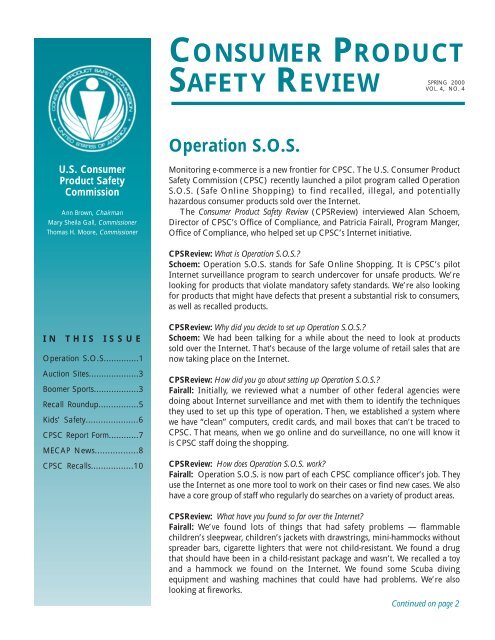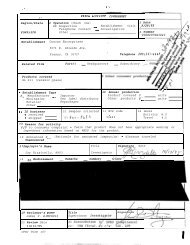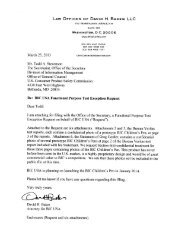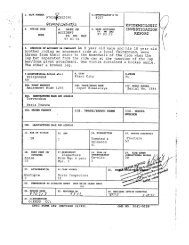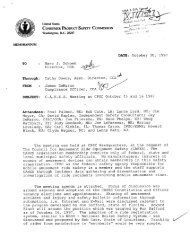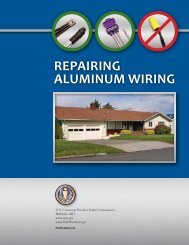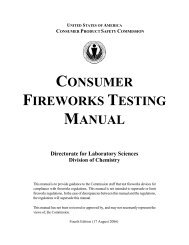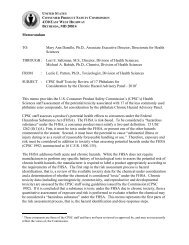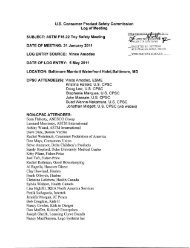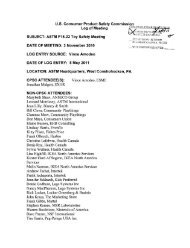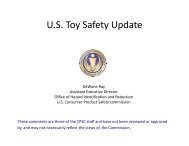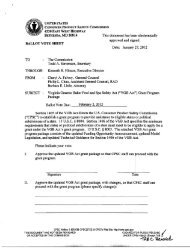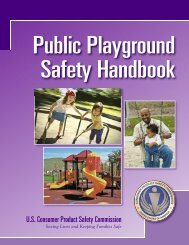Consumer Product Safety Review -Spring 2000 - CPSC
Consumer Product Safety Review -Spring 2000 - CPSC
Consumer Product Safety Review -Spring 2000 - CPSC
You also want an ePaper? Increase the reach of your titles
YUMPU automatically turns print PDFs into web optimized ePapers that Google loves.
U.S. <strong>Consumer</strong><br />
<strong>Product</strong> <strong>Safety</strong><br />
Commission<br />
Ann Brown, Chairman<br />
Mary Sheila Gall, Commissioner<br />
Thomas H. Moore, Commissioner<br />
IN THIS ISSUE<br />
Operation S.O.S..............1<br />
Auction Sites....................3<br />
Boomer Sports..................3<br />
Recall Roundup................5<br />
Kids’ <strong>Safety</strong>.....................6<br />
<strong>CPSC</strong> Report Form............7<br />
MECAP News.................8<br />
<strong>CPSC</strong> Recalls.................10<br />
CONSUMER PRODUCT<br />
SPRING <strong>2000</strong><br />
SAFETY REVIEW VOL. 4, NO. 4<br />
Operation S.O.S.<br />
Monitoring e-commerce is a new frontier for <strong>CPSC</strong>. The U.S. <strong>Consumer</strong> <strong>Product</strong><br />
<strong>Safety</strong> Commission (<strong>CPSC</strong>) recently launched a pilot program called Operation<br />
S.O.S. (Safe Online Shopping) to find recalled, illegal, and potentially<br />
hazardous consumer products sold over the Internet.<br />
The <strong>Consumer</strong> <strong>Product</strong> <strong>Safety</strong> <strong>Review</strong> (CPS<strong>Review</strong>) interviewed Alan Schoem,<br />
Director of <strong>CPSC</strong>’s Office of Compliance, and Patricia Fairall, Program Manger,<br />
Office of Compliance, who helped set up <strong>CPSC</strong>’s Internet initiative.<br />
CPS<strong>Review</strong>: What is Operation S.O.S.?<br />
Schoem: Operation S.O.S. stands for Safe Online Shopping. It is <strong>CPSC</strong>’s pilot<br />
Internet surveillance program to search undercover for unsafe products. We’re<br />
looking for products that violate mandatory safety standards. We’re also looking<br />
for products that might have defects that present a substantial risk to consumers,<br />
as well as recalled products.<br />
CPS<strong>Review</strong>: Why did you decide to set up Operation S.O.S.?<br />
Schoem: We had been talking for a while about the need to look at products<br />
sold over the Internet. That’s because of the large volume of retail sales that are<br />
now taking place on the Internet.<br />
CPS<strong>Review</strong>: How did you go about setting up Operation S.O.S.?<br />
Fairall: Initially, we reviewed what a number of other federal agencies were<br />
doing about Internet surveillance and met with them to identify the techniques<br />
they used to set up this type of operation. Then, we established a system where<br />
we have “clean” computers, credit cards, and mail boxes that can’t be traced to<br />
<strong>CPSC</strong>. That means, when we go online and do surveillance, no one will know it<br />
is <strong>CPSC</strong> staff doing the shopping.<br />
CPS<strong>Review</strong>: How does Operation S.O.S. work?<br />
Fairall: Operation S.O.S. is now part of each <strong>CPSC</strong> compliance officer’s job. They<br />
use the Internet as one more tool to work on their cases or find new cases. We also<br />
have a core group of staff who regularly do searches on a variety of product areas.<br />
CPS<strong>Review</strong>: What have you found so far over the Internet?<br />
Fairall: We’ve found lots of things that had safety problems — flammable<br />
children’s sleepwear, children’s jackets with drawstrings, mini-hammocks without<br />
spreader bars, cigarette lighters that were not child-resistant. We found a drug<br />
that should have been in a child-resistant package and wasn’t. We recalled a toy<br />
and a hammock we found on the Internet. We found some Scuba diving<br />
equipment and washing machines that could have had problems. We’re also<br />
looking at fireworks.<br />
Continued on page 2
<strong>Consumer</strong> <strong>Product</strong> <strong>Safety</strong> <strong>Review</strong> <strong>Spring</strong> <strong>2000</strong><br />
Operation S.O.S. Continued<br />
CPS<strong>Review</strong>: How is your surveillance of products over the<br />
Internet different from the surveillance of products found in<br />
brick and mortar stores?<br />
Schoem: In brick and mortar stores, we walk into retail<br />
stores and look for particular products. If we go online,<br />
we surf through different websites for products. If we<br />
suspect that a product violates a regulation or presents a<br />
safety hazard, we buy the product or, if the company is<br />
selling the product in the United States, we send an<br />
investigator on-site to take a look at it.<br />
Fairall: Internet searching saves us time, because<br />
investigators don’t have to drive out to lots of retail<br />
stores to search for products.<br />
CPS<strong>Review</strong>: Are you finding products you might not have<br />
found without Operation S.O.S.?<br />
Schoem: Quite possibly. For example, we might not have<br />
had easy access to some of the flammable sleepwear or<br />
drugs in non-child-resistant packaging. If something is only<br />
being sold online, going online is the only way you would<br />
find out about it. In addition, although cigarette lighters<br />
are sold through traditional brick and mortar stores, they<br />
were also being sold online. As Pat said, sometimes it’s a lot<br />
easier to go online and look for products than to run<br />
around to a lot of different retail stores.<br />
CPS<strong>Review</strong>: How many of the unsafe products you find come<br />
from Internet surveillance compared with traditional<br />
surveillance?<br />
Schoem: Right now, there’s a very small number from<br />
the Internet. But that’s going to grow. Over the next few<br />
months, we are going to look at the most efficient way to<br />
use the Internet to find unsafe products. As Internet<br />
sales grow, we’ll also be monitoring these sales in a<br />
much bigger way.<br />
CPS<strong>Review</strong>: How else are you using the Internet for<br />
surveillance?<br />
Fairall: We are also looking for silent recalls and<br />
violations of the requirement that firms report defective<br />
products that could create a substantial product hazard<br />
or products that present an unreasonable risk of serious<br />
injury or death. Sometimes firms silently recall a product<br />
that violates our regulations, and we want to identify<br />
them. We are also looking for firms, manufacturers, and<br />
importers selling products similar to the ones currently<br />
2<br />
being investigated — which helps us do a better job<br />
when we look at a group of products for various types of<br />
hazards. And, we are trying to find previously recalled<br />
products that continue to be sold online.<br />
CPS<strong>Review</strong>: Any other things you’re doing on the Internet?<br />
Fairall: We’re looking at various news groups and<br />
bulletin boards — looking for consumers who say a<br />
product breaks in a certain way that might present a<br />
substantial product hazard.<br />
CPS<strong>Review</strong>: The issue of Internet privacy is very big. Should<br />
the average consumer have anything to fear from <strong>CPSC</strong><br />
surveillance?<br />
Schoem: Not from us, because we are only looking at<br />
publicly available information. We are not looking at any<br />
information that may be restricted in some way. We are<br />
only going on websites and places where there is no<br />
expectation of privacy, and everybody understands that<br />
the information is public.<br />
CPS<strong>Review</strong>: Are you monitoring chat rooms?<br />
Fairall: We have not gone into chat rooms that are live.<br />
We have gone into news groups, message boards, and<br />
bulletin boards looking for posted messages where<br />
people alert other consumers to problems they have<br />
encountered with particular products.<br />
CPS<strong>Review</strong>: What about auction sites?<br />
Fairall: We have done a little bit of work on auction<br />
sites. We are looking more for firms selling large<br />
numbers of a product than a consumer selling one or<br />
two used items. (See Online “Double Check”, page 3.)<br />
CPS<strong>Review</strong>: How are you using the Internet to help businesses<br />
with their consumer product safety issues?<br />
Fairall: We want to provide advice and guidance to<br />
small businesses that may be just getting into Internet<br />
sales but are unaware of some of our regulations. This is<br />
a way for us to find and identify those types of firms and<br />
send them guidance, so they can be sure the products<br />
they sell are not hazardous.<br />
CPS<strong>Review</strong>: Do you have any final thoughts on how<br />
Operation S.O.S. will help <strong>CPSC</strong>’s compliance efforts?<br />
Schoem: We think Operation S.O.S. will be an<br />
important tool in our arsenal to find dangerous and<br />
violative products, which will help us better protect<br />
consumers.
Online “Double Check”<br />
<strong>CPSC</strong> recently announced an initiative with two of<br />
the largest auction websites — eBay Inc., of San<br />
Jose, CA and Amazon.com Auctions of Seattle, WA<br />
— to protect consumers from dangerous products<br />
sold online.<br />
Linking to <strong>CPSC</strong>’s website, eBay and<br />
Amazon.com Auctions will post guidance for<br />
consumers to help them get information about<br />
recalled products that may be offered for sale.<br />
Hundreds of hazardous products have been<br />
banned by <strong>CPSC</strong> or recalled over the years. While<br />
<strong>CPSC</strong> can get these products off store shelves,<br />
getting these products out of people’s homes is<br />
more difficult. Many items end up for sale by<br />
individuals on the increasingly popular auction<br />
websites.<br />
Children’s products and toys, tools, exercise<br />
equipment, and household items are the focus of<br />
this initiative.<br />
<strong>CPSC</strong> urges consumers to do a “Recall Double<br />
Check” when using online auctions: check before<br />
you sell, check before you buy. This “Recall<br />
Double Check” will be easier because of the links<br />
from eBay and Amazon.com Auctions sites to<br />
<strong>CPSC</strong> recall information.<br />
Customers of eBay can access a special <strong>CPSC</strong><br />
page on the eBay site that alerts consumers to the<br />
dangers of recalled products. This information is<br />
available with a link from both the bidder and<br />
seller forms for certain products, and the Tips for<br />
Buyers, Tips for Sellers, and Is my item allowed on eBay?<br />
sections of the eBay site.<br />
Amazon.com Auctions will include a link to<br />
<strong>CPSC</strong>’s website in the confirmation emails sent to<br />
bidders and sellers of tools, toys, exercise<br />
equipment, and other products. Links also are<br />
located at the Prohibited Content and Asking<br />
Questions About an Item sections on the site.<br />
Amazon.com Auctions will continue to monitor its<br />
site for recalled products and remove them as<br />
appropriate.<br />
To determine if any product has been recalled<br />
or banned, consumers can visit <strong>CPSC</strong>’s website<br />
at www.cpsc.gov or call <strong>CPSC</strong>’s toll-free Hotline at<br />
1-800-638-2772.<br />
<strong>Consumer</strong> <strong>Product</strong> <strong>Safety</strong> <strong>Review</strong> <strong>Spring</strong> <strong>2000</strong><br />
Baby Boomer Sports Injuries<br />
Sports-related injuries among those ages 35 to 54 — today’s<br />
baby boomers — increased about 33% from 1991<br />
to 1998, according to a recently-released <strong>CPSC</strong> report.<br />
There were just under 276,000 hospital emergency<br />
room-treated injuries to persons 35 to 54 in 1991 compared<br />
with slightly more than 365,000 sports injuries to<br />
persons of these ages in 1998.<br />
This increase in injuries, which occurred in 16 popular<br />
sports activities, was due primarily to increased numbers<br />
of baby boomers participating in these sports<br />
(Figure 1).<br />
When all medically-attended injuries in these popular<br />
sports were included, <strong>CPSC</strong> estimated there were a<br />
total of more than 1 million injuries to baby boomers in<br />
1998 (compared with 778,000 such injuries to persons<br />
35 to 54 in 1991). These sports injuries to baby boomers<br />
cost the nation over $18.7 billion in 1998.<br />
Bicycling and basketball were associated with the<br />
largest number of 1998 baby boomer sports injuries<br />
treated in hospital emergency rooms. Of special note<br />
(see below), baby boomers suffered a relatively high<br />
number of head injury-related deaths while bicycling.<br />
Baby boomers represented almost one-third of all<br />
Americans who participated in sports in 1998. These<br />
79.1 million people comprised over 29 percent of the total<br />
U.S. population. In 1998, there were 14 million more<br />
Americans in the 35 to 54 age group than in 1991.<br />
Sports Injuries and Deaths<br />
Seven sports showed significant increasing trends in the<br />
number of emergency room-treated injuries in the 35 to<br />
54 age group in 1998. These were: bicycling, golf, soccer,<br />
basketball, exercise and running, weightlifting, and inline<br />
skating. Participation data showed increases in baby<br />
boomers’ sports participation for most of these sports.<br />
(Information on how many people participated in<br />
weightlifting or exercise and running was not available.)<br />
Three sports showed significant decreasing trends in<br />
the number of emergency room-treated injuries and decreasing<br />
trends in the number of participants. These<br />
were: skiing, tennis and volleyball.<br />
For three sports, there were large numbers of deaths<br />
reported to <strong>CPSC</strong>. These were: bicycling (290 deaths a<br />
year, all but 35 motor vehicle-related); swimming (67<br />
Continued on page 4<br />
3
<strong>Consumer</strong> <strong>Product</strong> <strong>Safety</strong> <strong>Review</strong> <strong>Spring</strong> <strong>2000</strong><br />
deaths a year associated with swimming pools); and skiing<br />
(7 deaths a year).<br />
<strong>Safety</strong> Equipment-Related Issues<br />
Baby boomers who rode bicycles died from head injuries<br />
at nearly twice the rate as children who rode bikes. This<br />
difference is likely the result of greater helmet usage<br />
among children. According to <strong>CPSC</strong>, 69% of children<br />
wear helmets when bicycling compared with only 43%<br />
of baby boomers.<br />
Baby boomer in-line skaters, however, were injured<br />
less frequently than other skaters. In 1998, about 3.2 out<br />
of every 1,000 baby boomer in-line skaters were treated<br />
in an emergency room for a skating injury. Among children<br />
under 18, this number was 4.6 out of every 1,000.<br />
For the population as a whole, it was 4.1 per 1,000<br />
skaters. Baby boomers suffered a much smaller proportion<br />
of arm and hand injuries than other age groups,<br />
4<br />
Gymnastics<br />
Ice Hockey<br />
Snowboarding*<br />
Tennis<br />
Volleyball<br />
Boomer Sports Injuries<br />
Estimated Number of Emergency Room-Treated Injuries Among Persons 35-54 Years of Age, 1991 and 1998<br />
Swimming Pools<br />
Soccer<br />
In-Line Skating*<br />
Golf<br />
Football<br />
Weightlifting<br />
Skiing<br />
Exercise & Running<br />
Baseball & Softball<br />
Basketball<br />
Bicycles<br />
which may be an indication they are wearing appropriate<br />
protective equipment such as gloves, wrist guards,<br />
and elbow pads.<br />
Conclusion<br />
It is important for baby boomers to stay active and<br />
to participate in sports. But safety is an essential<br />
consideration.<br />
For example, baby boomers can reduce serious head<br />
injuries by wearing bike helmets when bike riding.<br />
Other sports-related injuries can be avoided or reduced<br />
by following such precautions as wearing other appropriate<br />
sports safety equipment, warming up before<br />
vigorous exercise, and increasing one’s amount of<br />
exercise gradually.<br />
— George W. Rutherford, Jr., M.S., Directorate for Epidemiology<br />
1991<br />
1998<br />
0 10,000 20,000 30,000 40,000 50,000 60,000 70,000<br />
SOURCE: U.S. <strong>Consumer</strong> <strong>Product</strong> <strong>Safety</strong> Commission, Directorate for Epidemiology, National Electronic Injury Surveillance System (NEISS)<br />
* NOTE: Injury data not collected in 1991<br />
Figure 1
Recall Round-up’s “Most Wanted”<br />
Bad guys are not the only ones to make the “Most<br />
Wanted” lists in post offices these days. As part of <strong>CPSC</strong>‘s<br />
recent “Recall Round-up <strong>2000</strong>,” dangerous recalled consumer<br />
products also are up on the walls of post offices<br />
around the country.<br />
<strong>CPSC</strong> and the U.S. Postal Service (USPS) recently<br />
worked together to post these recall notices on bulletin<br />
boards in all 33,000 post offices.<br />
The goal of Recall Round-up <strong>2000</strong> is to get hazardous<br />
products out of people’s homes. Despite recall notices and<br />
public warnings, consumers still use many products with the<br />
potential to seriously injure or kill. With more than seven<br />
million people entering post offices each day, these recall<br />
posters should help alert more people to possible dangers.<br />
In addition to the Postal Service’s help for Recall<br />
Round-up <strong>2000</strong>, <strong>CPSC</strong> enlisted the aid of state and local<br />
officials, and national and state health and safety organizations.<br />
Governors, state health officials, and grassroots voluntary<br />
and service groups helped publicize the safety<br />
campaign and distribute information about the<br />
hazardous products. In some states, recalled products were<br />
rounded up and brought to central locations for disposal.<br />
As part of Recall Round-up <strong>2000</strong>, <strong>CPSC</strong> encouraged<br />
safety checks of thrift stores, too many of which sell recalled,<br />
hazardous products. This year, officials in 32 states<br />
began visiting thrift stores to educate store owners about<br />
the dangers of selling recalled products and to help get<br />
hazardous products off the shelves.<br />
Recall Round-up <strong>2000</strong> highlighted the following hazardous<br />
products that might still be in consumers’ homes.<br />
Infant car seat/carriers with the handles that can unexpectedly<br />
release can cause the seat to flip forward and<br />
the infant to fall. Three brands of carriers have been recalled.<br />
<strong>CPSC</strong> knows of 160 injuries, including skull fractures<br />
and concussions, with all three recalled carriers. The<br />
recalled carriers are: Evenflo “On My Way” Model 207<br />
and 492 made before July 27, 1997 by Evenflo Company;<br />
Cosco “Arriva” and “Turnabout” models made before<br />
September 9, 1997 by Cosco Inc.; and Kolcraft “Infant<br />
Rider”, “Secura”, and other models made from January 1,<br />
1993 through June 30, 1999 by Kolcraft Enterprises.<br />
People should call these companies to get a free repair<br />
kit: Evenflo (800-203-2138); Cosco (800-221-6736); and<br />
Kolcraft (800-776-2609).<br />
Pokemon Balls included with Burger King kids meals<br />
may pose a suffocation hazard to children under age 3 if<br />
either half of the ball gets stuck on the child’s face, covering<br />
the nose and mouth. More than 25 million “Pokemon<br />
Balls” were distributed in November and December 1999.<br />
A 13-month-old girl and a 4-month-old boy reportedly suffocated<br />
when one-half of a Pokemon ball covered the<br />
<strong>Consumer</strong> <strong>Product</strong> <strong>Safety</strong> <strong>Review</strong> <strong>Spring</strong> <strong>2000</strong><br />
nose and mouth. In addition, <strong>CPSC</strong> is aware of several<br />
non-suffocation incidents. Take away the “Pokemon Balls”<br />
(including the clip) from children under age 3 and discard<br />
the ball. Or, return both halves to a Burger King<br />
restaurant for a free small order of French fries.<br />
Swimming pool dive sticks can cause rectal or vaginal<br />
impalement if children jump into a shallow pool and fall<br />
or land on the dive stick. <strong>CPSC</strong> knows of eight impalement<br />
injuries and four non-impalement injuries to children<br />
5 to 11 years old. People should stop using the hard<br />
plastic dive sticks and throw them out. Depending on the<br />
dive sticks owned, consumers can receive a refund, replacement,<br />
or repair.<br />
Television carts made by Sauder Woodworking Co.<br />
(models 5155, 5055, and 5251 made through September<br />
1998) and by Bush Industries Inc. (models 5414 and 5014<br />
from June 1992 to August 1998) can tip over and injure<br />
children and adults when the cart and the TV fall. There<br />
have been 15 reports of these carts tipping over, resulting<br />
in three injuries, including a 3-year-old girl who suffered a<br />
skull fracture. The carts were sold ready-to-assemble and<br />
had a bottom cabinet with hinged double doors. People<br />
should remove their televisions and VCRs from the carts<br />
and contact the manufacturer to get a free repair kit to<br />
help prevent the cart from tipping over. For Sauder, call:<br />
888-800-4590; for Bush, call: 800-950-4782.<br />
Tubular metal cribs made by Cosco Inc. before<br />
September 1997 can entrap or strangle a baby. These metal<br />
cribs can be mis-assembled with the mattress platform<br />
used as a side rail, creating a distance between the side rail<br />
slats that allows an infant to become entrapped. There<br />
have been 27 reports of babies becoming entrapped because<br />
of mis-assembly, resulting in one death. In addition,<br />
mattresses sold with Model “M” cribs and sold before<br />
October 1997 can compress and be pushed between the<br />
bars on the crib’s platform, permitting a baby to slip between<br />
the bars on the crib’s platform and become entrapped.<br />
Cosco has received 12 complaints of entrapment<br />
because of the compressed mattress, resulting in one<br />
death. Call the company to make sure the crib is properly<br />
assembled and to get a new, safer mattress at 800-221-6736.<br />
Cedar chests with lids that automatically latch shut<br />
when closed made by The Lane Co. between 1912 and<br />
1987 can pose a hazard. <strong>CPSC</strong> and Lane are aware of seven<br />
children suffocating inside the chests when the lid<br />
closed and automatically latched shut. Only those made<br />
between 1912 and 1987 are involved. Contact the company<br />
to get a free replacement lock to prevent entrapment<br />
at 888-856-8758.<br />
continured on page 6<br />
5
<strong>Consumer</strong> <strong>Product</strong> <strong>Safety</strong> <strong>Review</strong> <strong>Spring</strong> <strong>2000</strong><br />
Children’s <strong>Safety</strong> Initiatives<br />
<strong>CPSC</strong> recently initiated several partnerships to protect<br />
the lives of infants and young children.<br />
At <strong>CPSC</strong>’s urging, seven major retailers that sell bedding<br />
for infants have agreed to a safety campaign promoting<br />
safe bedding practices for babies. Babies “R” Us,<br />
IKEA, JCPenney, Kmart, Lands’ End, Sears, and Target,<br />
which account for the majority of baby bedding sales,<br />
are making changes to crib displays in retail stores, catalogs,<br />
advertisements, and websites.<br />
Shoppers will no longer see cribs made up with pillows,<br />
quilts, and comforters at these retailers. As many as<br />
900 baby deaths each year attributed to Sudden Infant<br />
Death Syndrome (SIDS) may be caused by suffocation<br />
from soft bedding items such as these.<br />
Many of these retailers will include cautionary statements<br />
about soft bedding for younger babies in their<br />
catalogs, on signs attached to cribs, and on inserts that<br />
accompany baby comforters and quilts.<br />
When featured in crib ads, babies will always be pictured<br />
sleeping on their backs. Some of the retailers will<br />
create bedding safety brochures for customers and add<br />
quilt racks to their nursery product lines.<br />
Since 1994, <strong>CPSC</strong> has warned about the danger of<br />
soft bedding to babies under 12 months. But consumers<br />
often got a different message when they went to stores<br />
or browsed through catalogs. Many cribs were made up<br />
with pillows and other soft bedding, which may have encouraged<br />
parents to use these items in cribs.<br />
<strong>CPSC</strong> has worked with manufacturers to get warning<br />
labels on infant pillows and is now working for a similar<br />
warning on baby quilts and comforters.<br />
Crib <strong>Safety</strong> at Hotels<br />
In another move to protect young children, <strong>CPSC</strong> and<br />
the National SAFE KIDS Campaign recently announced<br />
an initiative on crib and play yard safety to keep children<br />
Recall Round-up’s “Most Wanted”<br />
Continued from page 5<br />
Old cribs and other products made before <strong>CPSC</strong>’s<br />
safety standards can choke, strangle, or suffocate children.<br />
Old cribs with more than 2 3 /8 inches between crib<br />
slats, corner posts, or cut-outs on the headboard or footboard<br />
present suffocation and strangulation hazards.<br />
Bunk beds with spaces bigger than 3 1 /2 inches can cause<br />
entrapment and strangulation. Old chest freezers can<br />
suffocate children. Hairdryers without built-in shock-<br />
6<br />
safe when traveling with their families. Spot checks by<br />
SAFE KIDS found that about 80% of hotels and motels<br />
visited had unsafe cribs and play yards.<br />
Bass Hotels & Resorts, which includes the Inter-<br />
Continental, Holiday Inn, Holiday Inn Express,<br />
Staybridge Suites, and Crowne Plaza brands, initially<br />
joined the new safety initiative.<br />
Since the announcement, other hotel companies have<br />
joined the safety initiative. These include Wyndham,<br />
Omni, Hyatt, Hilton, Aero Inn, and Starwood.<br />
Bass Hotels & Resorts, for example, is providing additional<br />
training for staff. It held a “Crib <strong>Safety</strong> Week”,<br />
where each hotel’s housekeeping and maintenance staff<br />
conducted a thorough inspection of all cribs and play<br />
yards. The company also plans to include crib safety information<br />
in hotel publications, on its website, and at<br />
media events.<br />
SAFE KIDS visited 90 hotels and motels in 27 states<br />
and the District of Columbia. Of the cribs inspected,<br />
82% had at least one safety hazard, including loose hardware<br />
or lack of secured mattress supports that could entrap<br />
a baby; soft bedding, including quilts, comforters, or<br />
pillows that could cause suffocation; and adult-sized<br />
sheets that pose a strangulation and suffocation hazard.<br />
Of the play yards and mesh cribs inspected, 52% had<br />
at least one safety hazard, including soft bedding and<br />
tears or holes in the meshing, which pose an entrapment<br />
risk to babies.<br />
— Jacqueline Elder, Office of Hazard Identification and<br />
Reduction<br />
For hotel or motel stays with young children, call<br />
ahead to ask if there is a system in place to ensure<br />
that the cribs are safe. To check out <strong>CPSC</strong>’s crib<br />
safety checklist for consumers and a safety inspection<br />
checklist for hotels and motels, visit <strong>CPSC</strong>’s<br />
website at www.cpsc.gov or call the <strong>CPSC</strong> hotline at<br />
1-800-638-2772.<br />
protection devices in the plug can cause electrocution.<br />
Drawstrings around the neck of jackets and sweatshirts<br />
can strangle a child. Destroy these old hazardous products.<br />
Do not sell them at garage sales or give them to<br />
thrift stores.<br />
— Carol Cave, Directorate for Field Operations<br />
For more information about these and other consumer<br />
products, call <strong>CPSC</strong>‘s tollfree hotline at:<br />
1-800-638-2772 or visit its website at: www.cpsc.gov.
<strong>Consumer</strong> <strong>Product</strong> <strong>Safety</strong> <strong>Review</strong> <strong>Spring</strong> <strong>2000</strong><br />
<strong>Consumer</strong> <strong>Product</strong> Incident Report<br />
Please contact us about any injury or death involving consumer products. Call us toll free at: 1-800-638-8095.<br />
Visit our website at www.cpsc.gov. Or, fill out the form below. Send it to: U.S. <strong>Consumer</strong> <strong>Product</strong> <strong>Safety</strong><br />
Commission/EHDS, Washington, DC 20207 or fax it to: 1-800-809-0924. We may contact you for further<br />
details. Please provide as much information as possible. Thank you.<br />
YOUR NAME<br />
YOUR ADDRESS<br />
CITY STATE ZIP<br />
YOUR TELEPHONE<br />
NAME OF VICTIM (IF DIFFERENT FROM ABOVE)<br />
ADDRESS<br />
CITY STATE ZIP<br />
TELEPHONE<br />
DESCRIBE THE INCIDENT OR HAZARD, INCLUDING DESCRIPTION OF INJURIES<br />
VICTIM’S AGE SEX DATE OF INCIDENT<br />
DESCRIBE PRODUCT INVOLVED<br />
PRODUCT BRAND NAME/MANUFACTURER<br />
IS PRODUCT INVOLVED STILL AVAILABLE? � YES � NO PRODUCT MODEL AND SERIAL NUMBER<br />
WHEN WAS THE PRODUCT PURCHASED?<br />
This information is collected by authority of 15 U.S.C. 2054 and may be shared with product manufacturers, distributors, or retailers.<br />
No names or other personal information, however, will be disclosed without explicit permission.<br />
U.S. <strong>Consumer</strong> <strong>Product</strong> <strong>Safety</strong> Commission<br />
Washington, DC 20207<br />
PLEASE DUPLICATE THIS FORM FOR FUTURE USE. <strong>CPSC</strong> FORM 175A (6/96) OMB CLEARANCE NO. 3041-0029<br />
TC-49<br />
7
<strong>Consumer</strong> <strong>Product</strong> <strong>Safety</strong> <strong>Review</strong> <strong>Spring</strong> <strong>2000</strong><br />
8<br />
MECAP<br />
NEWS<br />
Medical Examiners and<br />
Coroners Alert Project and<br />
Emergency Physicians<br />
Reporting System<br />
The MECAP-EPRS Project is<br />
designed to collect timely<br />
information on deaths and<br />
injuries involving consumer<br />
products. Please contact us<br />
whenever you encounter a<br />
death or situation that you<br />
believe should be considered<br />
during a safety evaluation of<br />
a product.<br />
To report a case or ask for<br />
information about MECAP,<br />
please call our toll-free<br />
number, 1-800-638-8095,<br />
or our toll-free fax number,<br />
1-800-809-0924, or send a<br />
message via Internet to<br />
AMCDONAL@<strong>CPSC</strong>.GOV.<br />
*Indicates cases selected for<br />
<strong>CPSC</strong> follow-up investigations.<br />
Cases reported but not<br />
selected for follow-up also<br />
are important to <strong>CPSC</strong>. Every<br />
MECAP report is included in<br />
<strong>CPSC</strong>’s injury data base and<br />
will be used to assess the<br />
hazards associated with<br />
consumer products.<br />
During the months of December 1999,<br />
and January and February <strong>2000</strong>, 609<br />
cases were reported to <strong>CPSC</strong>. Included<br />
here are samples of cases to illustrate<br />
the type and nature of the reported<br />
incidents.<br />
ASPHYXIATIONS/<br />
SUFFOCATIONS<br />
* A male, 17 months, was put in a<br />
playpen at his babysitter’s. Soon after,<br />
the child began to turn blue and<br />
Emergency Medical Services was<br />
called. Paramedics found a green<br />
miniature pool ball lodged in the<br />
back of his throat. The child was taken<br />
to the hospital where he died two<br />
days later. The cause of death was asphyxiation.<br />
(Daniel S. Heinz,<br />
Coroner, Peoria County, Peoria, IL)<br />
*A male, 3 months, was put to<br />
sleep on the bottom bunk of a bunk<br />
bed by his grandmother. A comforter<br />
and pillow were placed between<br />
the bunk bed and the wall to<br />
eliminate a gap. The next morning,<br />
the grandmother found the baby<br />
lodged between the mattress and<br />
the wall; the comforter had dislodged.<br />
The cause of death was positional<br />
asphyxiation.<br />
(L. J. Dragovic, M.D., Chief Medical<br />
Examiner, Oakland County, Pontiac,<br />
MI)<br />
POISONINGS<br />
*Two men, 51 and 34, went on a<br />
hunting trip. They were found, unresponsive,<br />
in their sleeping bags in<br />
a tent by a friend. The tent was<br />
sealed and contained a working<br />
propane heater with a blue flame<br />
around the heating element. The<br />
cause of death was carbon monoxide<br />
intoxication.<br />
(Marcus Nashelsky, M.D., Medical<br />
Investigator, Albuquerque, NM)<br />
A female, 33, was found unresponsive<br />
in the apartment she had<br />
moved into the day before. The cap<br />
to a boiler exhaust vent was closed in<br />
the boiler room next to her apartment.<br />
This caused carbon monoxide<br />
to seep into her apartment. The<br />
cause of death was carbon monoxide<br />
poisoning.<br />
(Bruce Hyma, M.D., Assistant<br />
Medical Examiner, District 11, Dade<br />
County, Miami, FL)<br />
*A male, 61, and his wife, 51,<br />
were found in their van with two<br />
empty camping lanterns. Both<br />
lanterns had their valves in an open<br />
position. The cause of their deaths<br />
was carbon monoxide poisoning.<br />
(Patricia J. McFeeley, M.D., Assistant<br />
Chief Medical Investigator,<br />
Albuquerque, NM)<br />
A male, 84, was found dead due<br />
to a malfunctioning liquid propane<br />
refrigerator. The cause of death was<br />
carbon monoxide poisoning.<br />
(Lynn Reed, Coroner, Moultrie<br />
County, Sullivan, IL)<br />
*A male, 65, was found dead in his<br />
home due to an unventilated propane<br />
gas floor heater. The cause of death<br />
was carbon monoxide intoxication.<br />
(Marcus Nashelsky, M.D., Medical<br />
Investigator, Albuquerque, NM)<br />
DROWNINGS<br />
A female, 1, was found unresponsive<br />
in the family swimming pool.<br />
The pool was equipped with a child<br />
safety fence, but the gate was left<br />
open, which enabled the child to enter<br />
the pool. The cause of death was<br />
drowning.<br />
(Susan Gabriel for Thomas Beaver,<br />
M.D., Chief Medical Examiner,<br />
District 7, Volusia County, Daytona<br />
Beach, FL)<br />
*A male, 8 months, was left in a<br />
bathtub in a flotation device while<br />
his mother went to the kitchen to<br />
cook some rice. The mother returned<br />
to check on him because he
was quiet. She found him out of the<br />
flotation device and under water.<br />
The unresponsive child was taken<br />
to the hospital, where he died the<br />
next day. The cause of death was<br />
drowning.<br />
(William Hamilton, M.D., Chief<br />
Medical Examiner, District 8,<br />
Gainesville, FL)<br />
A male, 2, was found under the solar<br />
cover of his family’s above-ground<br />
pool. The child had been left alone<br />
momentarily by his mother, who was<br />
attending to her other child. A closed<br />
gate blocked access to the stairs of the<br />
deck surrounding the pool. An investigator<br />
theorized that the child had<br />
slipped through the railings of the<br />
deck stairway or had climbed between<br />
the steps themselves from the backside<br />
of the stairway. The cause of<br />
death was drowning.<br />
(Richard R. Ballinger, Coroner, Du<br />
Page County, Wheaton, IL)<br />
A female, 17 months, was found in<br />
the family pool by her mother. The<br />
child apparently opened French doors<br />
at the back of the house, untied the<br />
rope holding a broken gate closed, and<br />
entered the pool. The cause of death<br />
was drowning.<br />
(Carlos A. Fonseca, M.D., Deputy<br />
Medical Examiner, Morris County,<br />
Morristown, NJ)<br />
A female, 17 months, was found<br />
floating in the swimming pool at her<br />
home. She had been locked in a<br />
bedroom with her mother while her<br />
mother showered. One of her siblings<br />
had entered the bedroom and<br />
left the door unlocked. The child exited<br />
the bedroom and made her way<br />
to the unfenced pool. The cause of<br />
death was drowning.<br />
(Joseph F. Blaise, M.D., Forensic<br />
Pathologist Resident, District 11,<br />
Dade County, Miami, FL)<br />
A male, 2, was found in the swimming<br />
pool of his home by his mother.<br />
The child opened two locked<br />
doors and a cage around the pool<br />
while his mother was on the telephone.<br />
He died almost eight weeks<br />
after the incident. The cause of<br />
death was complications due to near<br />
drowning.<br />
(Marie H. Hansen, M.D., Associate<br />
Medical Examiner, District 6, Largo,<br />
FL)<br />
A female, 12 months, was left in a<br />
bathtub with the water slowly running<br />
and the drain open — so the<br />
tub wouldn’t fill up. Her sister, 3, was<br />
also in the bathroom but not in the<br />
tub. Their mother went back and<br />
forth between the bathroom and the<br />
kitchen while preparing dinner. The<br />
3-year-old told her mother that her<br />
sister had fallen, and the mother<br />
found the younger child lying in the<br />
tub water. The cause of death was<br />
drowning.<br />
(Noel Palma, M.D., Medical<br />
Examiner, District 15, Palm Beach<br />
County, West Palm Beach, FL)<br />
ELECTROCUTION<br />
A male, 34, received a fatal electric<br />
shock when he plugged a fan he<br />
was wiring into an outlet. The cause<br />
of death was electrocution.<br />
(Carol Koop for Susan Roe, M.D.,<br />
Medical Examiner, Ramsey County,<br />
St. Paul, MN)<br />
FIRES<br />
A male, 74, died in a flash fire in<br />
his camper. He had changed the<br />
propane tanks in the morning and<br />
returned in the evening to close up<br />
the camper. He lit a disposable charcoal<br />
lighter inside the camper, which<br />
ignited the propane and caused a<br />
flash fire. The cause of death was<br />
thermal injuries.<br />
(Jeffery Jentzen, M.D., Medical<br />
Examiner, Milwaukee County,<br />
Milwaukee, WI)<br />
<strong>Consumer</strong> <strong>Product</strong> <strong>Safety</strong> <strong>Review</strong> <strong>Spring</strong> <strong>2000</strong><br />
*A female, 46, died in an electrical<br />
fire. A faulty electrical wire<br />
caught a sofa on fire. The cause of<br />
death was asphyxiation due to<br />
smoke and soot inhalation.<br />
(Dolores Butler for I. C. Hood,<br />
M.B., ChB., Deputy Medical<br />
Examiner, Philadelphia, PA)<br />
A female, 31, and four children,<br />
ages 1, 2, 4, and 9, died in a house<br />
fire caused by a gas dryer. The<br />
cause of their deaths was carbon<br />
monoxide poisoning.<br />
(Carol Koop for Susan Roe, M.D.,<br />
MedicaF Examiner, Ramsey<br />
County, St. Paul, MN)<br />
MISCELLANEOUS<br />
*A male, 5, was sitting on the<br />
crossbar of his sister’s 10-speed<br />
bike. The brakes did not work, and<br />
they ran head-on into a guardrail<br />
at the end of a dead-end street.<br />
Both children, who were not wearing<br />
helmets, were thrown from the<br />
bike, and the male struck the<br />
guardrail. His sister did not receive<br />
serious injuries. The cause of<br />
death was blunt trauma to the<br />
chest.<br />
(Michael A. Graham, M.D., Chief<br />
Medical Examiner, St. Louis, MO)<br />
*A male, 8 months, died when<br />
he fell from a bed onto a space<br />
heater. He was found wedged between<br />
the bed and a wall. The<br />
cause of death was complications<br />
from thermal injuries.<br />
(Carol Koop for Michael B.<br />
McGee, M.D., Chief Medical<br />
Examiner, Ramsey County, St.<br />
Paul, MN)<br />
— Denny Wierdak, Directorate for<br />
Epidemiology<br />
9
<strong>Consumer</strong> <strong>Product</strong> <strong>Safety</strong> <strong>Review</strong> <strong>Spring</strong> <strong>2000</strong><br />
10<br />
<strong>CPSC</strong> Recalls<br />
The following product recalls were conducted by firms in cooperation with<br />
<strong>CPSC</strong>. For more information about recalls, visit <strong>CPSC</strong>’s website at<br />
www.cpsc.gov.<br />
<strong>Product</strong>: About 755,000 18-volt battery packs by the DEWALT®<br />
Industrial Tool Co. The battery packs, for use with various batteryoperated<br />
tools, are model number DW9095. The model number<br />
is located on the nameplate on the bottom of the battery pack.<br />
The battery packs have date codes from 9719 to 9810 located on<br />
the top of the battery pack. The battery packs are black with “DE-<br />
WALT,” and “18V” in yellow on the sides of the packs. Major<br />
home centers and hardware stores, as well as industrial distributors,<br />
sold the battery packs nationwide from May 1997 through<br />
June 1998 for between $70 and $85. Battery packs with an “R”<br />
etched after the date code or with a red dot on the name plate already<br />
have been repaired and are not included in this recall.<br />
Problem: The battery packs’ clips can come loose causing the battery<br />
packs to fall. A falling battery pack weighing about 2.2<br />
pounds can cause injury. DEWALT has received 53 reports of battery<br />
packs falling from the tools. There have been five reports of<br />
injuries, including a battery pack striking a consumer on the<br />
head.<br />
What to do: Stop using the battery packs and call DEWALT® for<br />
a free repair kit toll free at 1-877-457-0478 between 8 a.m. and<br />
4:30 p.m. ET Monday through Friday or go to the company’s web<br />
site at www.dewalt.com/pressroom/fullstory.asp?article=27.<br />
<strong>Product</strong>: About 1.9 million in-wall electric heaters by Cadet<br />
Manufacturing Co. The heaters are Cadet and Encore brands:<br />
FW, FX, LX, TK, ZA, Z, RA, RK, RLX, RX and ZC distributed<br />
mainly in California, Idaho, Montana, Oregon and Washington.<br />
The brand and model are located on a label on the front of the<br />
heat box, behind the grill. This recall announcement follows the<br />
resolution of the lawsuit filed by <strong>CPSC</strong> staff against the company<br />
on January 14, 1999.<br />
Problem: The <strong>CPSC</strong> alleges that the over-temperature limit<br />
switches, the heating elements and internal wiring connections<br />
are defective and can fail. <strong>CPSC</strong> alleges that the electric heaters<br />
are defective and can overheat and catch fire. Flames, sparks or<br />
molten particles can spew through the front grill cover of the<br />
heater into the living area of a residence, putting consumers at<br />
risk from fire, including burn injuries, smoke inhalation and<br />
property damage. The heaters can also become energized creating<br />
a risk of electric shock. <strong>CPSC</strong> is aware of more than 320 reports<br />
of heaters that smoked, sparked, caught fire, emitted flames,<br />
or ejected burning particles or molten material. The incidents<br />
have allegedly resulted in three deaths, two serious burn injuries<br />
and property damage claims exceeding $1.2 million, which include<br />
five partial or total house fires.<br />
What to do: Cadet is offering consumers replacement heaters at<br />
a significantly reduced cost. Each heater will cost between $25<br />
and $57, depending on the model. <strong>Consumer</strong>s who already have<br />
replaced the recalled units from October 23, 1997 until February<br />
17, <strong>2000</strong> can file a claim for partial reimbursement for $25 per<br />
heater. <strong>Consumer</strong>s must register to participate in this recall by<br />
February 17, 2002. To register, contact Cadet anytime at 1-800-<br />
567-2613 or at www.cadetco.com/recallprogram.html.<br />
<strong>Product</strong>: About 126,000 ceiling-mounted light fixtures. The light fixtures<br />
are TSI Prime, Inc. four-bulb, flush mount with an eight-sided<br />
glass and brass enclosure. A sticker on the fixture near the base of<br />
one of the light sockets reads, “MADE IN CHINA,” and “E181045.”<br />
Wal-Mart and Lowe’s stores nationwide sold the light fixtures for between<br />
$16 and $25. Wal-Mart sold the fixtures individually packaged<br />
from February 1998 through March 1999. Lowe’s sold the fixtures in<br />
two-packs from January 1998 through January <strong>2000</strong>.<br />
Problem: The light fixtures can short circuit and pose a fire hazard.<br />
TSI Prime has received three reports of these light fixtures<br />
short circuiting, resulting in scorch marks on the ceiling. No injuries<br />
have been reported.<br />
What to do: Stop using the lights immediately and call TSI Prime<br />
to arrange for a free replacement. For more information, call TSI<br />
Prime toll-free at 1-877-317-9237 between 8 a.m. and 5 p.m. CT<br />
Monday through Friday.<br />
<strong>Product</strong>: About 136,000 cans of fire and smoke suppressant by<br />
various distributors for The Colbra Group. The Colbra Group is<br />
now out of business. The 16-ounce “FIRE CAP” brand aerosol<br />
cans are red, orange, yellow, black, and white with a red plastic<br />
cap and red aerosol button. Wording on the front of the can<br />
reads in part, “FIRE CAP...FIRE and SMOKE SUPPRESSANT.”<br />
“FOR USE ON SMALL SPOT FIRES...” is on the back of the can<br />
along with drawings of the product being used on a trash can fire,<br />
a stove fire, a car fire, and a campfire. “Manufactured by the<br />
Colbra Group” is written on the back of the can. Snap-On Tools<br />
dealers, Home Shopping Network, and direct market distributors,<br />
including Mid-State Fire Systems and Contract Filling Inc., sold<br />
the product nationwide from February 1996 through September<br />
1999 for about $10.<br />
Problem: The fire and smoke suppressant does not suppress fires<br />
and could intensify fires. <strong>CPSC</strong> is not aware of any incidents or injuries<br />
with this product.<br />
What to do: Stop using the product immediately and either<br />
throw out the can or return it to the place where purchased for a<br />
full refund. <strong>Consumer</strong>s should call <strong>CPSC</strong>’s toll-free hotline at 1-<br />
800-638-2772 for instructions on returning the product to the<br />
place of purchase.<br />
<strong>Product</strong>: About 35,000 power strips by Champion Power Strips-<br />
Frieder Inc. The 6-outlet 125-volt power strip is made in China<br />
and bears no UL listing. The back of the power strip has a date<br />
code indicating it was manufactured on 4/97. Writing on the<br />
cord includes “Chang RVV 300/500V.” “Champion Quality<br />
Tools” and model number 10741 are written on the packaging.<br />
Discount outlets nationwide sold the power strips from January<br />
1997 through July 1998 for about $3.<br />
Problem: The wiring in these power strips is undersized and poses<br />
shock, electrocution, and fire hazards. No incidents or injuries<br />
have been reported involving these products.<br />
What to do: Stop using these power strips and return them to the<br />
store where purchased for a refund or send them to Frieder for a<br />
refund plus postage. For more information, consumers should<br />
call Frieder at 1-800-321-8192 between 8:30 a.m. and 5 p.m. ET<br />
Monday through Friday.<br />
<strong>Product</strong>: About 19,000 mountain bikes by Dynacraft Industries<br />
Inc. The chrome-framed mountain bikes have model name<br />
“Vertical XL2” written on the bike frame in yellow and black lettering.<br />
A label affixed to the frame near the crank reads “Model<br />
No. 8526-26” and “99.10.11,” which show they were manufactured
the week of October 11, 1999. Only bikes with this date code are<br />
part of this recall. Target stores nationwide sold these mountain<br />
bikes from November 1999 through February <strong>2000</strong> for about $140.<br />
Problem: The front suspension forks might not have been welded<br />
properly and can break apart during use resulting in serious injury<br />
to the rider. Dynacraft has received eight reports of injuries to riders<br />
when the front forks on these bikes broke apart. Injuries included<br />
cuts, bruises, back strain, and chipped and lost teeth.<br />
What to do: Stop riding these bikes and take them to the Target<br />
store where purchased for a choice of a free replacement fork or a<br />
free replacement bike. For more information or to receive a free<br />
replacement fork by mail, call Dynacraft Industries Inc. at 1-800-<br />
551-0032 between 7 a.m. and 4 p.m. PT Monday through Friday.<br />
<strong>Product</strong>: About 44,000 jogging strollers by InSTEP LLC. The recall<br />
involves InSTEP and HEALTHRIDER brand single and double<br />
jogging strollers manufactured from December 1998 through July<br />
1999 with the model numbers: ZS100, ZD200, ZS100WS,<br />
ZD200WS, ZS100HR, ZD200HR, PR100 or PR200. The manufacturing<br />
date, written as T “month” R “year” I is located on a sticker<br />
on the lower cross tube (for example, T01R99I is January 1999).<br />
“InSTEP” and the model number are also on the sticker.<br />
Burlington Coat Factory, J.C. Penney, Healthrider, The Sports<br />
Authority, and Target stores nationwide, among others, sold the<br />
strollers from December 1998 through July 1999 for about $100 for<br />
a single jogger and $250 for a double jogger.<br />
Problem: The stroller’s brake can fail causing the stroller to unexpectedly<br />
roll away resulting in injury to a child. InSTEP LLC has received<br />
five reports of brakes failing. No injuries have been<br />
reported.<br />
What to do: Stop using the strollers and contact InSTEP LLC to<br />
receive a free easy-to-install repair kit. To order the repair kit or for<br />
more information, call InSTEP LLC at 1-800-242-6110 between 8<br />
a.m. and 5 p.m. CST Monday through Friday, or access the company’s<br />
web site at www.instep.net.<br />
<strong>Product</strong>:: About 152,000 baby wipe warmers by Advance Thermo<br />
Control (ATC). The Prince Lionheart Baby Wipe Warmer is an<br />
electric appliance with style number 0224 and date codes between<br />
9803 and 9901. The style number and date code are written on the<br />
bottom of the units and “PRINCE LIONHEART” is written on the<br />
lid. “Santa Maria, CA USA” and “MADE IN CHINA” are written on<br />
the bottom of the units. Toy, department, and baby specialty<br />
stores, including Toys “R” Us and Burlington Coat Factory, and<br />
mail order catalogs sold these wipe warmers nationwide from<br />
February 1998 through December 1999 for about $25.<br />
Problem: Cracks in the interior tub of these wipe warmers can allow<br />
water to contact the electrical components and result in consumers<br />
receiving an electric shock. Prince Lionheart has received<br />
four reports of electric shocks when consumers touched the wipes<br />
in the warmers with cracked tubs.<br />
What to do: Unplug the warmers, remove the wipes, and check to<br />
see if the interior tub is cracked. If so, stop using the warmer and<br />
call ATC for more information on receiving a free replacement<br />
unit. If the tub of the wipe warmer is not cracked, the unit is not<br />
part of the recall, and consumers can continue to use the appliance.<br />
For more information, contact ATC at 1-888-843-8718 between<br />
9 a.m. and 5 p.m. CT Monday through Friday.<br />
— Marc Schoem and John Shumlansky, Office of Compliance<br />
<strong>Consumer</strong> <strong>Product</strong> <strong>Safety</strong> <strong>Review</strong> <strong>Spring</strong> <strong>2000</strong><br />
Baby <strong>Product</strong>s and SIDS<br />
<strong>CPSC</strong> is warning consumers about certain baby mattresses<br />
and pads that claim to reduce the risk of Sudden Infant<br />
Death Syndrome (SIDS). These products encourage the<br />
potentially deadly practice of placing babies to sleep on<br />
their stomachs.<br />
Despite these claims, <strong>CPSC</strong> is not aware of any evidence<br />
proving that babies can be placed safely to sleep on their<br />
stomachs on these products, or that using the products will<br />
reduce the risk of SIDS.<br />
The risk of SIDS is significantly reduced by placing babies<br />
to sleep on their backs in a crib that meets current<br />
safety standards and has a firm, tight-fitting mattress and no<br />
soft bedding.<br />
The four products involved in <strong>CPSC</strong>’s action have<br />
been sold for about $30 to $100 in baby, drug, and discount<br />
department stores; in catalogs; and on the Internet,<br />
including the following web sites: www.sidsprevent.com,<br />
www.kidsafeprod.com, and flashmall.com.<br />
Due to <strong>CPSC</strong>’s efforts, these firms have stopped manufacturing<br />
and distributing these products. The following<br />
products make the claims through their advertising and<br />
marketing, including their instructions and packaging.<br />
<strong>CPSC</strong> has asked retailers to stop selling these products and<br />
remove them from store shelves immediately.<br />
The four products involved in <strong>CPSC</strong>’s action:<br />
Baby Air (Breathable Mattress)<br />
Kid Safe<br />
Van Nuys, Calif.<br />
5,000 sold*<br />
A wood frame covered by mesh fabric. Used in place of or<br />
on top of mattress.<br />
Breathe Easy Vented Infant Sleeping Surface<br />
U.S. Family <strong>Product</strong>s<br />
Willard, Mo.<br />
33,000 sold*<br />
Ridged foam mattress pad with air holes. Used on top of<br />
mattress.<br />
Sleep Guardian Sleeping Pad<br />
Sleep Guardian<br />
Charleston, S.C.<br />
600 sold*<br />
Vinyl pad with open weave fabric cover attached to an air<br />
pump. Used on top of mattress.<br />
Sleep Safe Mattress Cover<br />
Jupiter Industries<br />
Ontario, Canada<br />
1,000 sold*<br />
Mesh fabric mattress cover.<br />
*Estimated quantity sold<br />
11
✄<br />
Don’t miss a single issue of the quarterly <strong>Consumer</strong> <strong>Product</strong> <strong>Safety</strong> <strong>Review</strong>.<br />
Complete the subscription form below or visit <strong>CPSC</strong>’s web site at http://www.cpsc.gov.<br />
United States Government<br />
Information<br />
Order Processing Code: *5822<br />
Credit card orders are welcome!<br />
Fax your orders (202) 512-2250<br />
Phone your orders (202) 512-1800<br />
� YES, please send ____ subscriptions to:<br />
<strong>Consumer</strong> <strong>Product</strong> <strong>Safety</strong> <strong>Review</strong> (SAFRE) at $12.00 a<br />
year ($15.00 foreign).<br />
The total cost of my order is $ ______________.<br />
Price includes regular shipping & handling and is subject to change.<br />
Company or personal name (Please print or type)<br />
Additional address/attention line<br />
Street address<br />
City, State, Zip code<br />
Daytime phone including area code<br />
Puchase order number (optional)<br />
<strong>Consumer</strong> <strong>Product</strong> <strong>Safety</strong> <strong>Review</strong> is published quarterly by the U.S.<br />
<strong>Consumer</strong> <strong>Product</strong> <strong>Safety</strong> Commission, Washington, DC 20207.<br />
For subscription inquiries, contact:<br />
Superintendent of Documents (see above).<br />
For editorial correspondence, contact:<br />
Nancy Sachs, <strong>CPSC</strong><br />
Phone: 301-504-0554/Fax: 301-504-0407.<br />
For marketing inquiries, contact:<br />
Lynn Barclay or Lola <strong>Spring</strong>er, <strong>CPSC</strong><br />
Phone: 301-504-0106/Fax: 301-713-0047.<br />
U.S. CONSUMER PRODUCT SAFETY COMMISSION<br />
WASHINGTON, D.C. 20207<br />
OFFICIAL BUSINESS<br />
PENALTY FOR PRIVATE USE, $300<br />
An Equal Opportunity Employer<br />
For privacy protection, check box below:<br />
� Do not make my name available to other mailers<br />
Check method of payment:<br />
� Check payable to: Superintendent of Documents<br />
� GPO Deposit Account ������� – �<br />
� VISA � Mastercard<br />
��������������������<br />
Expiration date ����<br />
Authorizing signature 5/96<br />
Mail to:<br />
Superintendent of Documents<br />
P.O. Box 371954<br />
Pittsburgh, PA 15250-7954<br />
Important: Please include this completed order form with<br />
your remittance.<br />
Thank you for your order!<br />
To report consumer product-related injuries or for information on<br />
product safety, including recalls, contact <strong>CPSC</strong> by:<br />
Toll-free Hotline: 1-800-638-2772<br />
World Wide Web: http://www.cpsc.gov<br />
E-mail address: info@cpsc.gov<br />
Fax-on-demand service: call 301-504-0051 from the handset of a fax<br />
machine<br />
TTY for hearing and speech-impaired: 1-800-638-8270


